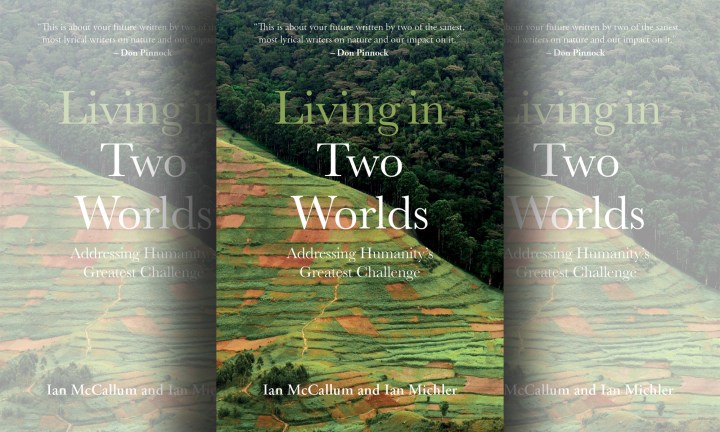BOOK EXCERPT
Living in Two Worlds – Addressing humanity’s greatest challenge

In ‘Living in Two Worlds’ authors Ian McCallum and Ian Michler explore a shared concern ‘for the fate and welfare of wild animals and habitats of the world’.
African conservationists, environmentalists and authors Ian McCallum and Ian Michler went on a “four-month, 5,000 km non-motorised journey – walking, kayaking, and cycling – through six countries across southern Africa, from the Atlantic Ocean in the West to the Indian Ocean in the East”. The book is about the insights “that emerged from this epic journey form questions that demand to be answered by all human beings. These are concerns that highlight the greatest ecological challenges of our time; climate change, the loss of species and habitat as well as our collective search for sustainable ways of living.”
Daily Maverick’s Don Pinnock has said about the book, “this is about your future written by two of the sanest, most lyrical writers on nature and our impact on it.” Here is an excerpt.
***
The idea of following in the tracks of elephants was first voiced by Ian Michler in 1998. He, my wife, Sharon and I were sitting around a campfire at the Linyanti Tented Camp – a comfortable but rustic guest camp in the remote, beautiful region of northern Botswana.
The three of us were employed by safari organisation Wilderness Safaris. Ian and I worked as guides and Sharon took the role of camp manager. There were no guests in the camp that mid-November night and there we were, the three of us, sitting around the campfire: Ian and Sharon with a glass of wine, and me with a cold beer. The ritual night call of red-billed francolins began to sound, followed by another evening ritual: a resident flock of 30 or more helmeted guineafowl lined up one behind the other. Each in turn flew up to their chosen roosting position on the branches of the large jackalberry tree above us.
There was something missing in that ritualistic evening display. It was the dry season in Botswana, and each night we had feasted on the sight and sounds of countless elephant herds coming in from the forest to drink from the Linyanti River, which was a mere stone’s throw from where we were sitting. The first early summer rains had fallen a day or two before, and with it had come the dramatic disappearance of the elephants. What had happened to them?
The answer was fairly simple: with the promise of the oncoming rainy season, it was as if the elephants had taken it upon themselves to rely instead on whatever water would fall and collect in the shallow clay-based pans that dotted the region. Their absence felt strange, and I was missing them. Then Ian spoke up: ‘How about, one day, we do a circular walk … following the elephant migration routes through the Caprivi, into Zambia, Zimbabwe and back to Botswana?’ he asked.
My reply was almost immediate: ‘Sounds great … following in the tracks of giants … Why not?’ I asked, raising my glass to toast the fascinating idea.
The seed was sown. Little did we know that seed would take 12 years to grow and flourish, and that the eventual fruit would look a lot different from what we had imagined.
Our circular, four-country plan transformed into a 5,000-km transect – walking, kayaking and cycling – through six southern African countries: Namibia; Botswana; Zambia; Zimbabwe; Mozambique and South Africa. The original idea to follow international elephant migration paths was replaced by the more realistic notion of following elephant cluster groups within those six countries. In reality, for historical, political and social reasons, elephant migration routes no longer exist in the way they did in the early part of the century but identifying those cluster groups helped us to define the route of our undertaking.
You may well wonder why it took 12 years to take our first physical steps. The answer can be summed up in three words: Logistics, integration and imagination. First was the challenge of the logistics. Without a considerable degree of planning, permissions, and not least, the necessary financial and organisational support we received from various organisations and individuals, the expedition could not have happened.
We needed a backup crew, along with two vehicles. One vehicle was to go ahead of the riders to find and set up campsites, buy food and drink, and prepare and sort out passport issues at national borders. The other was to come from behind with baggage, bicycles and repair equipment. For a high-quality record of the journey, we needed a professional filmmaker … and so the list went on. To implement and integrate those requirements, we required a project manager. As reluctant as she may have been when her name was suggested, Sharon took on the role. With a background in legal conveyancing, she was familiar with extensive planning and had a sharp eye for detail. I don’t know of anyone who could have done a better job.
As for imagination, we needed to keep the dream of the journey alive. It wasn’t that difficult. I think there is a deep sense and longing for adventure in every one of us – a nomadic spirit if you wish. After all, who wouldn’t leap at the opportunity to be part of an adventure like that? However, there was a more serious side to the stirrings of our imagination. In the years that followed that night around the fire in the Linyanti, Ian Michler, through his investigative research, public presentations, writings and skill as a wilderness guide, had become an increasingly respected and challenging environmental journalist. As a columnist and features writer for Africa Geographic, it was no secret that Peter Borchert, the founder and then-editor of the magazine, would sometimes suffer sleepless nights, wondering whether or not to publish Ian’s findings. Ian had also committed to delivering a slate of five natural history and travel books to a well-known publishing house.
My voice for the wild came in another form: Through writing, presentations and conferences. During those 12 years I had put together two anthologies of wilderness poems, Wild Gifts and Untamed, as well as a book, Ecological Intelligence – Rediscovering Ourselves in Nature. It became the foundation of my work as a ‘specialist’ guide. While working with Ian, our friendship deepened. When integrating facts, figures and science with metaphors and poetry, as well as insights into the evolutionary and psychological significance of wild animals in our lives, we fed off each other. We knew what we wanted. We wanted to be advocates for the wild places and animals of Africa. Taking those thoughts further, in 2001 we formed a safari organisation, Invent Africa. Our intention and mission statement were clear: ‘Dedicated to wilderness awareness.’
With that background and mission statement, the reason for the Tracks of Giants initiative became increasingly urgent. It was important to do something in the name of wild animals and their threatened habitats. The title spelt it out. Elephants would be the focus and flagship species of our journey. Our aim and purposes were as follows:
- To promote the importance of transfrontier conservation corridors. These would allow wild animals, especially elephants, to move freely across both local and international boundaries.
- To engage with local human communities living in or around protected areas on issues ranging from human-wildlife conflict to their living conditions and benefits from land use and ownership.
- To explore and assess the contentious issue of hunting versus tourism as a way to ensure the future of all wild animals.
- To meet and learn from some of the ‘human giants’; those doing the invaluable work at the coalface of conservation.
Upon completion, our intention had been to write a book – In the Tracks of Giants – about our journey … the physical, social and emotional challenges and not least, the wild animal encounters. However, in the days, months and early years following our adventure, subtle, yet important insights began to consolidate. Those insights shaped the way this book – Living in Two Worlds – was to be written. They emerged in the form of questions that will demand an answer from all human beings in the years to come. These questions, we believe, serve as the greatest ecological challenges of our time. It is what this book addresses:
What is it going to take to question our current values, lifestyles, beliefs, perspectives and understanding of a biosphere in which we co-exist with all living things … that the wild animals in the world are in our blood and in our psyche… that we need them more than they need us? Who and what would we be without them?
Could it be that elephants are not only one of many keystone species of the wild, but rather, large, grey mirrors of the fate of all wild animals, including us?
How are we going to communicate the environmental message in a way that promotes us – each in our own way – to take action? DM/ ML/ OBP


















Comments - Please login in order to comment.